Alterations in Suitable Cultivation Area for Scutellaria baicalensis under Future Climatic Scenarios in China: Geodetector-Based Prediction
Abstract
1. Introduction
2. Materials and Methods
2.1. Data Sources
2.2. Methods
2.2.1. Indices for Suitability Assessment
2.2.2. Geodetector Model
2.2.3. Suitability Assessment of Cultivation Area
2.2.4. Spatial Analysis
3. Results
3.1. Performance of the Assessment Model
3.2. Influence of Contributing Variables on Spatial Heterogeneity of S. baicalensis
3.3. Distribution Pattern of Suitability under Current and Future Climatic Condition
3.4. Shifts of Suitable Cultivation Area under Climate Change
3.5. Distribution Boundaries of S. baicalensis in China under Climate Change
4. Discussion
4.1. Interactive Effect of Different Variables on the Density of S. baicalensis
4.2. Uncertainty in the Projection of Future Suitability
4.3. Suitability at the Province Scale
5. Conclusions
Supplementary Materials
Author Contributions
Funding
Data Availability Statement
Conflicts of Interest
References
- Committee of Flora of China. Flora of China; Science Press: Beijing, China, 1977; Volume 65. (In Chinese) [Google Scholar]
- Chinese Pharmacopoeia Committee. Pharmacopoeia of The Peoples Republic of China; China Medical Science Press: Beijing, China, 2020. [Google Scholar]
- Zhao, Q.; Chen, X.Y.; Martin, C. Scutellaria baicalensis, the golden herb from the garden of Chinese medicinal plants. Sci. Bull. 2016, 61, 1391–1398. [Google Scholar] [CrossRef]
- Shan, Z.; Zhang, Q.; Qi, Y.; Ye, J.; Hao, D.; Xiao, P.; Cao, L.; Sun, J.; Zhao, L.; Niu, Y.; et al. Production regionalization of commonly used medicinal plants in China based on botanical big data. Ind. Crop. Prod. 2023, 202, 117024. [Google Scholar] [CrossRef]
- IPCC (Intergovernmental Panel on Climate Change). Working Group I to the Sixth Assessment Report of the Intergovernmental Panel on Climate Change. In Climate Change 2021: The Physical Science Basis; Masson-Delmotte, V., Zhai, P., Pirani, A., Connors, S.L., Péan, C., Chen, Y., Goldfarb, L., Gomis, M., Gomis, M.I., Berger, S., et al., Eds.; Cambridge University Press: Cambridge, UK; New York, NY, USA.
- Wu, D.; Wang, P.; Hou, Z.; Yuan, X.; Jiang, H.; Yang, J.; Tang, J.; Ma, Y. Changes in climate suitability for oil-tea (C. oleifera Abel) production in China under historical and future climate conditions. Agric. For. Meteorol. 2022, 316, 108843. [Google Scholar] [CrossRef]
- Prevéy, J.; Parker, L.; Harrington, C.; Lamb, C.; Proctor, M. Climate change shifts in habitat suitability and phenology of huckleberry (Vaccinium membranaceum). Agric. For. Meteorol. 2020, 280, 107803. [Google Scholar] [CrossRef]
- Jayasinghe, S.; Kumar, L. Modeling the climate suitability of tea [Camellia sinensis (L.) O. Kuntze] in Sri Lanka in response to current and future climate change scenarios. Agric. For. Meteorol. 2019, 272–273, 102–117. [Google Scholar]
- Davis, M.; Shaw, R. Range shifts and adaptive responses to quaternary climate change. Science 2001, 292, 673–679. [Google Scholar] [CrossRef] [PubMed]
- Li, F. Effects of Heredity and Environment on Yield and Quality of Scutellaria baicalensis and Its Mechanism; Beijing University of Chinese Medicine: Beijing, China, 2011. [Google Scholar]
- Summers, D.M.; Bryan, B.A.; Crossman, N.D.; Meyer, W.S. Species vulnerability to climate change: Impacts on spatial conservation priorities and species representation. Glob. Chang. Biol. 2012, 18, 2335–2348. [Google Scholar] [CrossRef]
- Wu, Y.; Miao, C.; Fan, X.; Gou, J.; Zhang, Q.; Zheng, H. Quantifying the uncertainty sources of future climate projections and narrowing uncertainties with bias correction techniques. Earth’s Future 2022, 10, e2022EF002963. [Google Scholar] [CrossRef]
- Roloff, G.J.; Kernohan, B.J. Evaluating reliability of habitat suitability index models. Wildl. Soc. Bull. 1999, 27, 973–985. [Google Scholar]
- Yang, F.; Zhou, W.; Zhao, X.; Zhang, J.; Shao, Z. Habitat suitability evaluation for Angelica dahurica planting in Yanting county, Sichuan province based on GIS. China J. Chin. Meteria. Medica 2019, 44, 3705–3710. (In Chinese) [Google Scholar]
- Zhang, W.; Wang, J.; Yin, Y. Theory and Practice of Digital Regional Cartridge for Authentic Medicinal Material; Science Press: Beijing, China, 2014. (In Chinese) [Google Scholar]
- Muhammed, K.; Anandhi, A.; Chen, G. Comparing methods for estimating habitat suitability. Land 2022, 11, 1754. [Google Scholar] [CrossRef]
- Wang, J.; Li, X.; Christakos, G.; Liao, Y.; Zhang, T.; Zheng, X. Geographical detectors-based health risk assessment and its application in the neural tube defects study of the Heshun Region, China. Int. J. Geogr. Inf. Sci. 2010, 24, 107–127. [Google Scholar] [CrossRef]
- Liao, Y.; Wang, X.Y.; Zhou, J.M. Suitability assessment and validation of giant panda habitat based on geographical detector. J. Geogr. Sci. 2016, 18, 767–778. (In Chinese) [Google Scholar]
- Jiang, Y.; Zhao, Z.; Xiao, Y.; Xu, H. Identifying the habitat quality of Scutellaria baicalensis based on baicalin content using the fuzzy matter element model. Ecol. Indic. 2022, 141, 109033. [Google Scholar] [CrossRef]
- Cheng, L.; Han, M.; Yang, L.M.; Yang, L.; Sun, Z.; Zhang, T. Changes in the physiological characteristics and baicalin biosynthesis metabolism of Scutellaria baicalensis Georgi under drought stress. Ind. Crop. Prod. 2018, 122, 473–482. [Google Scholar] [CrossRef]
- Zhou, G.; Liu, J.; Li, X.; Xu, N.; Zhu, W.; Meng, F. Evaluation for ecological adaptability of Scutellariae Radix and effects of environmental variables on chemical components. Chin. J. Exp. Tradit. Med. Form. 2016, 22, 28–32. (In Chinese) [Google Scholar] [CrossRef]
- Guo, L.; Wang, S.; Zhang, J.; Yang, G.; Zhao, M.; Ma, W.; Zhang, X.; Li, X.; Han, B.; Chen, N.; et al. Effects of ecological factors on secondary metabolites and inorganic elements of Scutellaria baicalensis and analysis of geoherblism. Sci. China Life Sci. 2013, 56, 1047–1056. [Google Scholar] [CrossRef]
- Costine, B.; Zhang, M.; Chhajed, S.; Pearson, B.; Chen, S.; Nadakuduti, S. Exploring native Scutellaria species provides insight into differential accumulation of flavones with medicinal properties. Sci. Rep. 2022, 12, 13201. [Google Scholar] [CrossRef] [PubMed]
- Sun, W.; Zeng, W.; Jia, X.; Zhang, Y.; Liu, Y. A comprehensive study on the differences between Scutellaria Baicalensis Georgi metabolism at different latitudes and longitudes. Chin. Pharm. J. 2023, 58, 1554–1562. (In Chinese) [Google Scholar]
- Wang, X.; Zhang, S.; Duan, Y.; Wang, Y.; Ma, Y.; Ke, S.; Shen, Y. Investigation and analysis on difference of cultivation technique situation of Scutellaria baicalensis in the main production areas of China. For. Ecol. Sci. 2024, 39, 34–40. (In Chinese) [Google Scholar]
- Xu, X.; Lu, Y.; Zhu, Y.; Zhu, H.; Zhang, X.; Jin, L. Study on ecological suitability of Scutellaria baicalensis Georgi. Chin. J. Inf. Tradit. Chin. Med. 2024, 31, 1–5. (In Chinese) [Google Scholar]
- Ji, B.; Liu, M.; Pei, L.; Yang, L. Ecologically suitable areas for growing Scutellaria baicalensis worldwide: An analysis based on GMPGIS. China J. Chin. Mater. Med. 2021, 46, 4389–4394. (In Chinese) [Google Scholar]
- Wen, M. ISSR Genetic Diversity Analysis and Core Germplasm Construction Method of Scutellaria baicalensis; Shaanxi Normal University: Xian, China, 2012. [Google Scholar]
- Aiello-Lammens, M.; Boria, R.; Radosavljevic, A.; Vilela, B.; Anderson, R. spThin: An R package for spatial thinning of species occurrence records for use in ecological niche models. Ecography 2015, 38, 541–545. [Google Scholar] [CrossRef]
- He, J.; Yang, K.; Tang, W.; Lu, H.; Qin, J.; Chen, Y.; Li, X. The first high-resolution meteorological forcing dataset for land process studies over China. Sci. Data 2020, 7, 25. [Google Scholar] [CrossRef]
- Fick, S.E.; Hijmans, R.J. WorldClim 2: New 1km spatial resolution climate surfaces for global land areas. Int. J. Climatol. 2017, 37, 4302–4315. [Google Scholar] [CrossRef]
- Chen, S. (Ed.) Ecological Suitability Regionalization of Medicinal Materials in China, Revised ed.; Science Press: Beijing, China, 2016. (In Chinese) [Google Scholar]
- Wang, J.; Xu, C. Geodetector: Principles and prospects. J. Geogr. Sci. 2017, 1, 116–134. [Google Scholar]
- Zhou, Z. Machine Learning.; Springer Nature Pte Ltd: Singapore, 2021. [Google Scholar] [CrossRef]
- Zheng, D. A Study on the EcoGeographic Regional System of China. In Proceedings of the FAO FRA2000 Global Ecological Zoning Work2shop, Cambridge, UK, 28–30 July 1999; p. 12. [Google Scholar]
- Zhang, K.; Yao, L.; Meng, J.; Tao, J. MaxEnt modeling for predicting the potential geographical distribution of two peony species under climate change. Sci. Total Environ. 2018, 634, 1326–1334. [Google Scholar] [CrossRef] [PubMed]
- Liang, S.; Wu, W.; Sun, J.; Li, Z.; Sun, X.; Chen, H.; Chen, S.; Fan, L.; You, L.; Yang, P. Climate-mediated dynamics of the northern limit of paddy rice in China. Environ. Res. Lett. 2021, 16, 064008. [Google Scholar] [CrossRef]
- Chen, M.; Zhang, L.; Cao, B.; Bai, C. Predictive suitable distributions and principal environment variables of six medicinal plants of Scutellaria based on MaxEnt and GIS. J. Tradit. Chin. Veteri. Med. 2022, 41, 7–11. [Google Scholar]
- Xu, N.; Meng, F.; Zhou, G.; Li, Y.; Wang, B.; Lu, H. Assessing the suitable cultivation areas for Scutellaria baicalensis in China using the Maxent model and multiple linear regression. Biochem. Syst. Ecol. 2020, 90, 104052. [Google Scholar] [CrossRef]
- Liu, J.; Li, G.; Xia, Y.; Ma, C.; Zhao, C.; Meng, F. Study on estimating reserves of wild Seutellaria baicalensis in Inner Mongolia region based on 3S technology. Chin. Tradit. Herb. Drugs 2016, 47, 997–1003. [Google Scholar]
- Swets, J. Measuring the accuracy of diagnostic systems. Science 1988, 240, 1285–1292. Available online: https://www.jstor.org/stable/1701052 (accessed on 16 February 2023). [CrossRef] [PubMed]
- Lehner, F.; Deser, C.; Maher, N.; Marotzke, J.; Fischer, E.M.; Brunner, L.; Knutti, R.; Hawkins, E. Partitioning climate projection uncertainty with multiple large ensembles and CMIP5/6. Earth Syst. Dyn. 2020, 11, 491–508. [Google Scholar] [CrossRef]
- Kim, K.B.; Kwon, H.H.; Han, D. Bias correction methods for regional climate model simulations considering the distributional parametric uncertainty underlying the observations. J. Hydrol. 2015, 530, 568–579. [Google Scholar] [CrossRef]
- Gampe, D.; Schmid, J.; Ludwig, R. Impact of reference dataset selection on RCM evaluation, bias correction, and resulting climate change signals of precipitation. J. Hydrometeorol. 2019, 20, 1813–1828. [Google Scholar] [CrossRef]
- Zhang, R.; Zhang, M.; Chen, Y.; Wang, C.; Zhang, C.; Heuberger, H.; Li, H.-T.; Li, M.-H. Future development of Good Agricultural Practice in China under globalization of traditional herbal medicine trade. Chin. Herb. Med. 2021, 13, 472–479. [Google Scholar] [CrossRef]
- World Health Organization (WHO). Traditional medicine-growing needs and potential. Medicine 2015, 2, 1–6. [Google Scholar]
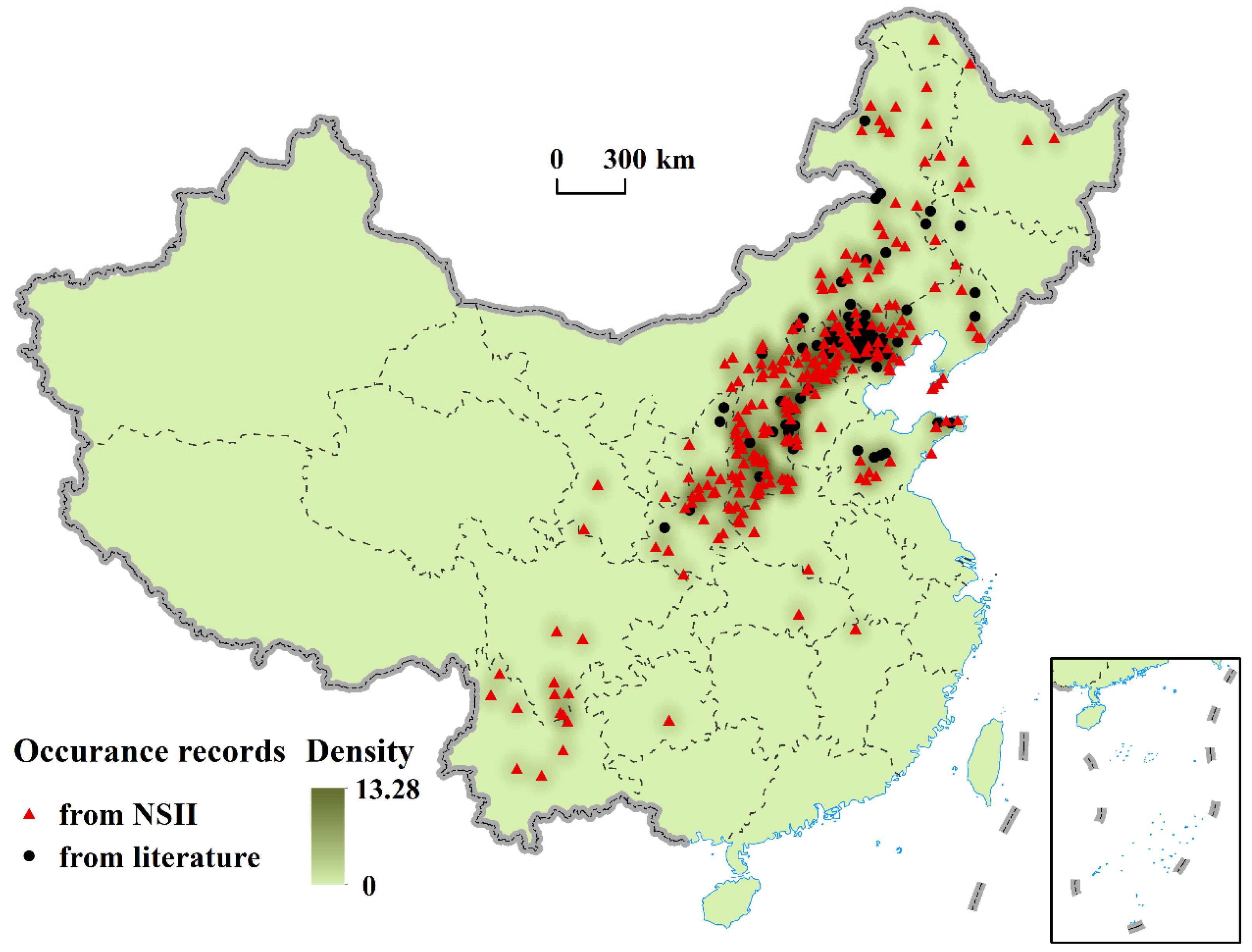
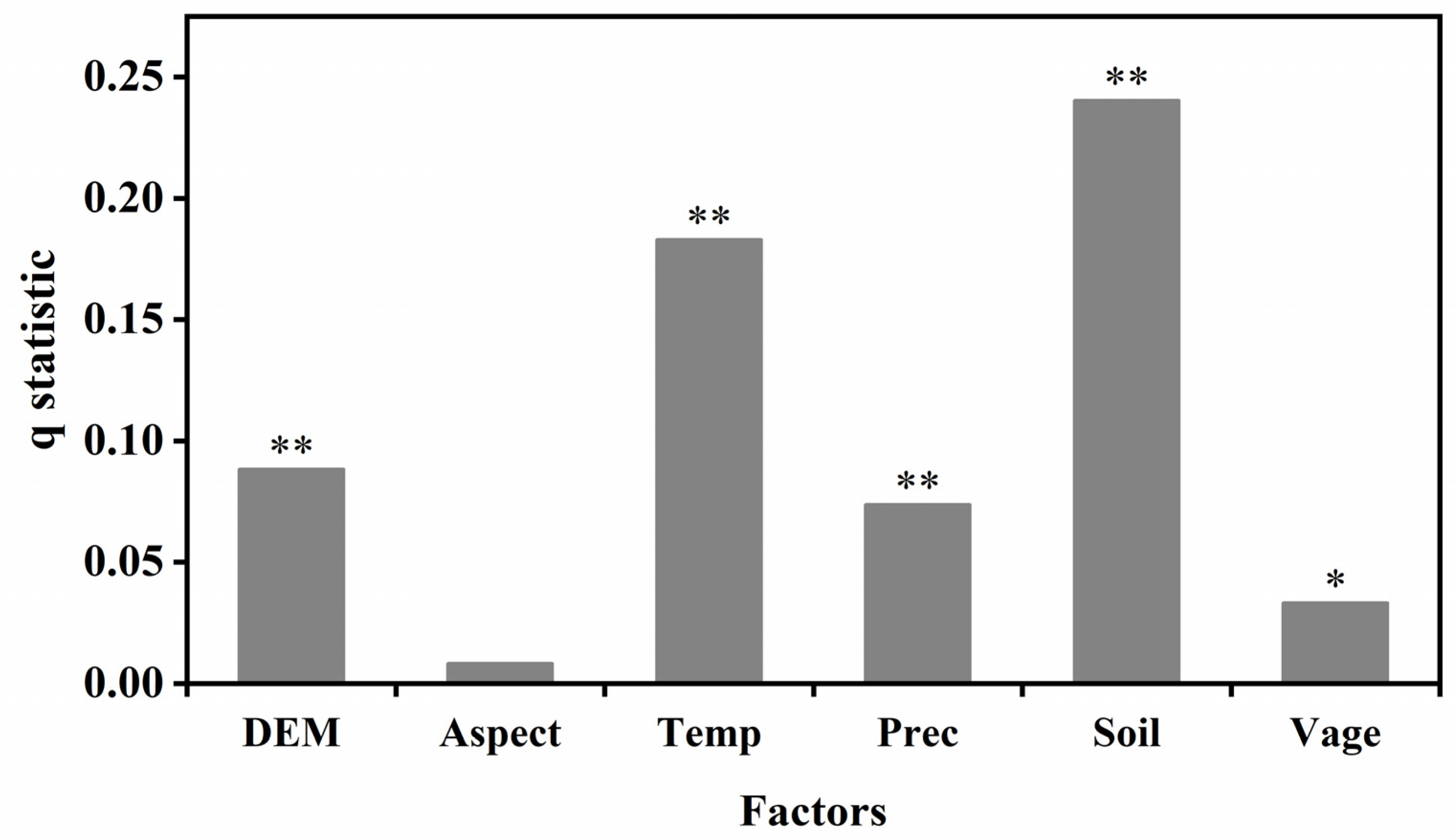

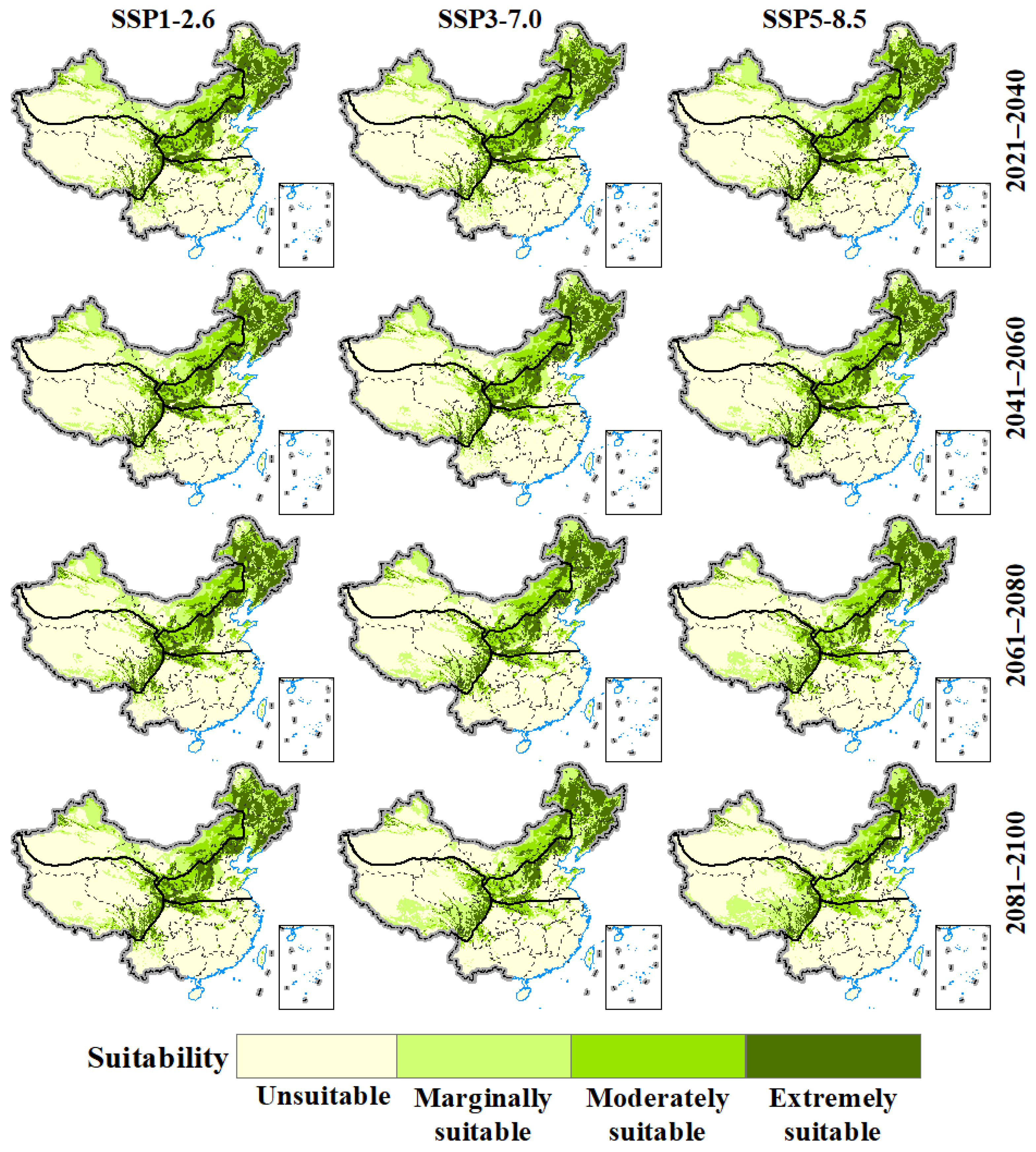
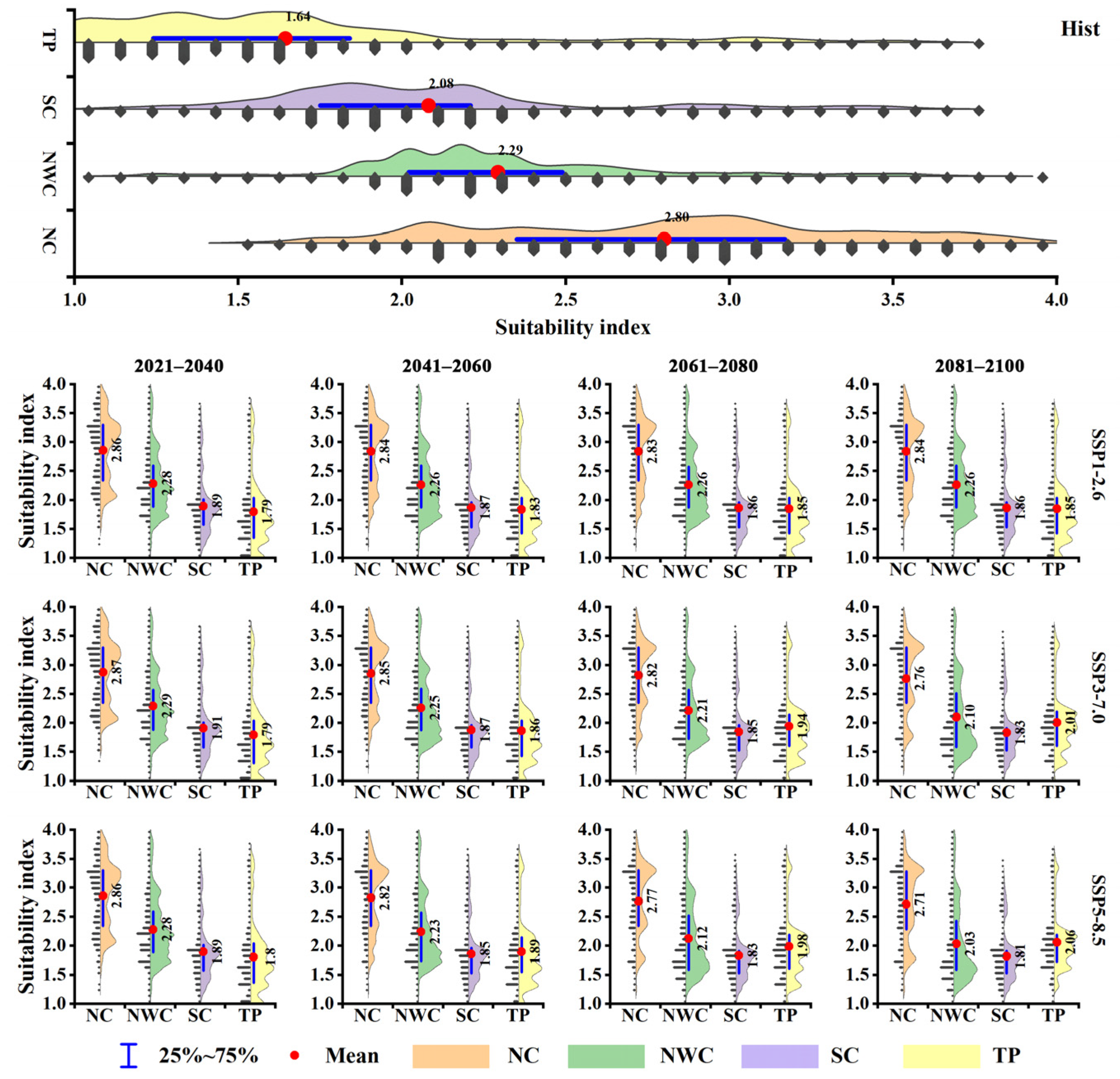
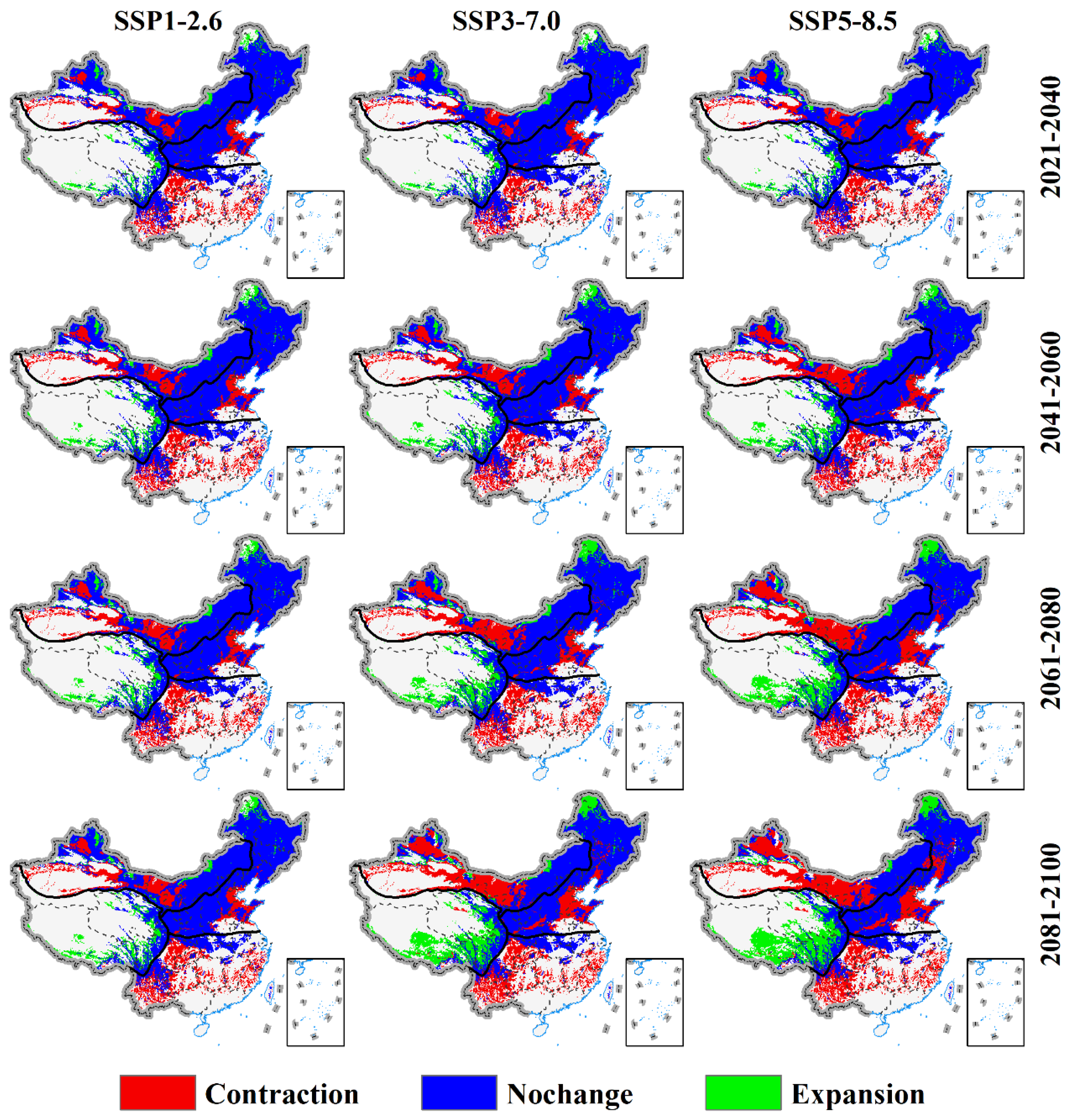
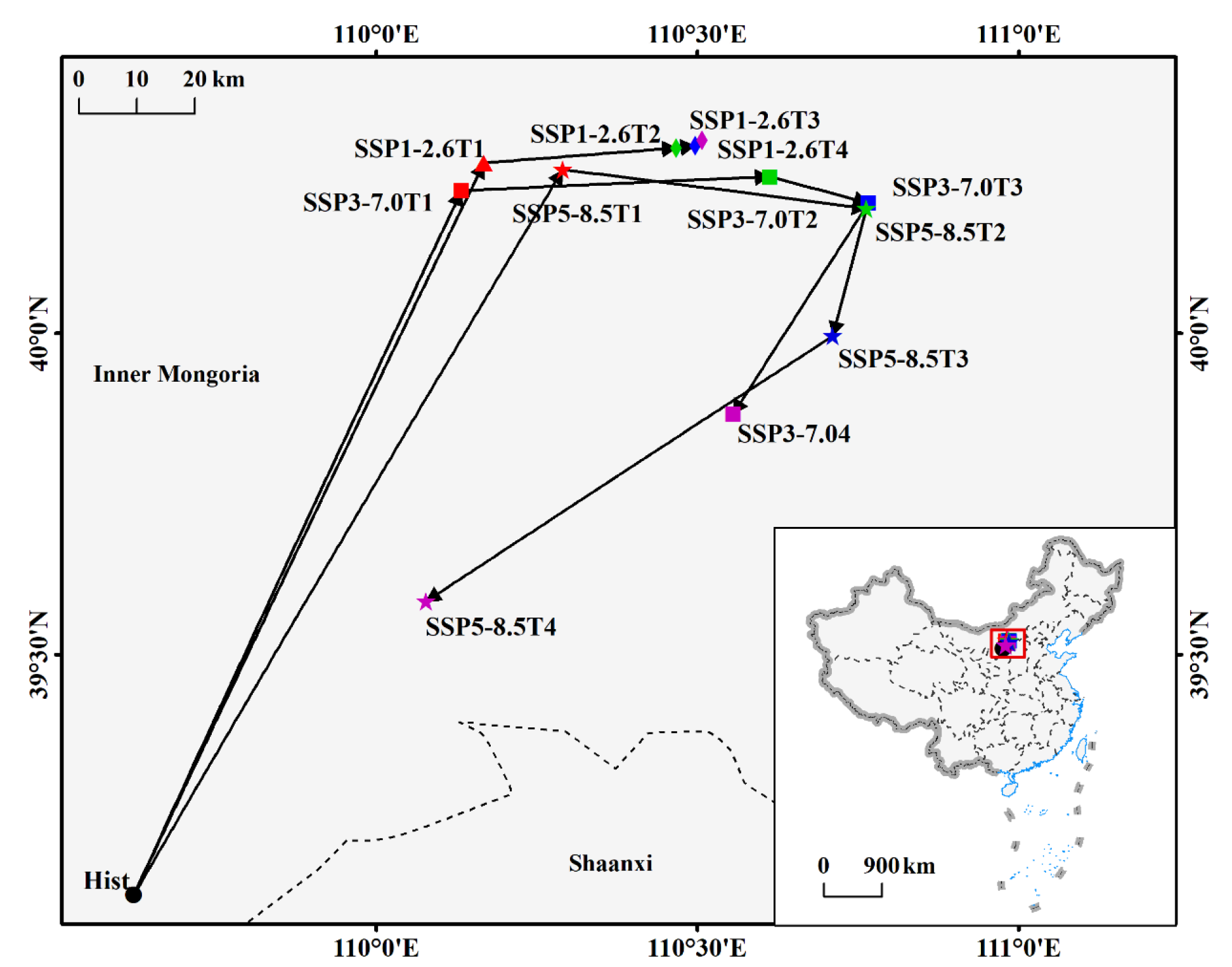
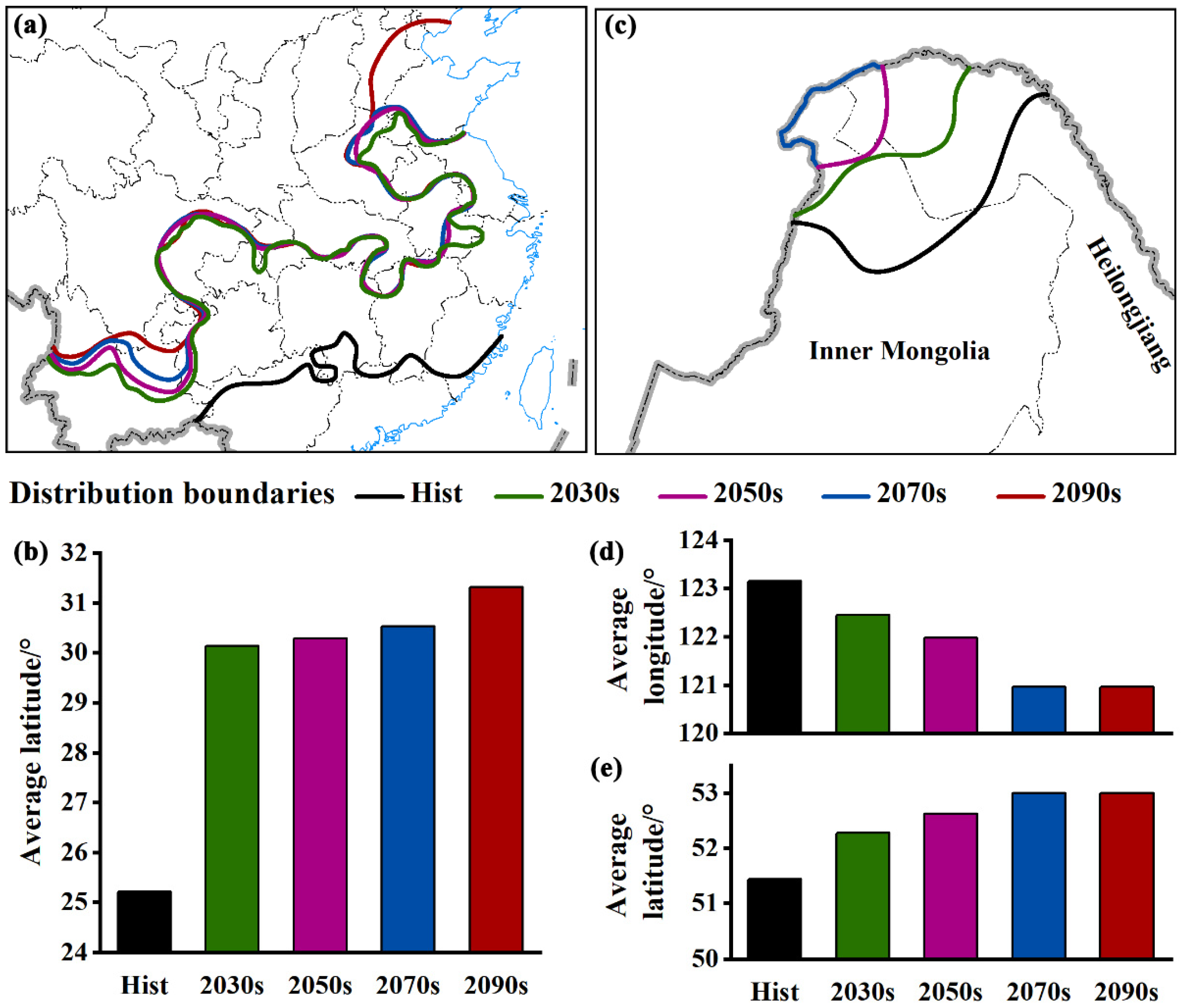
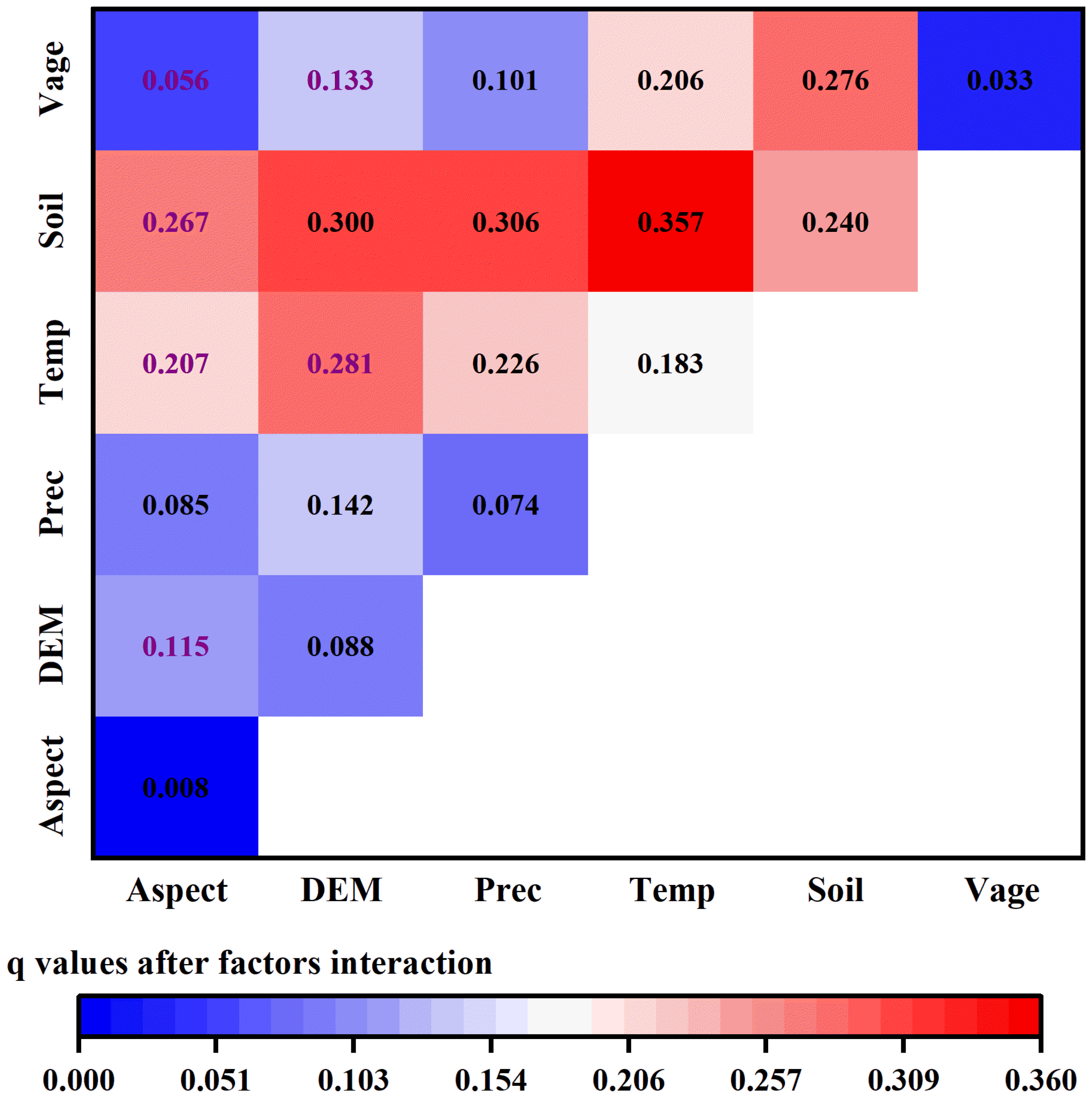

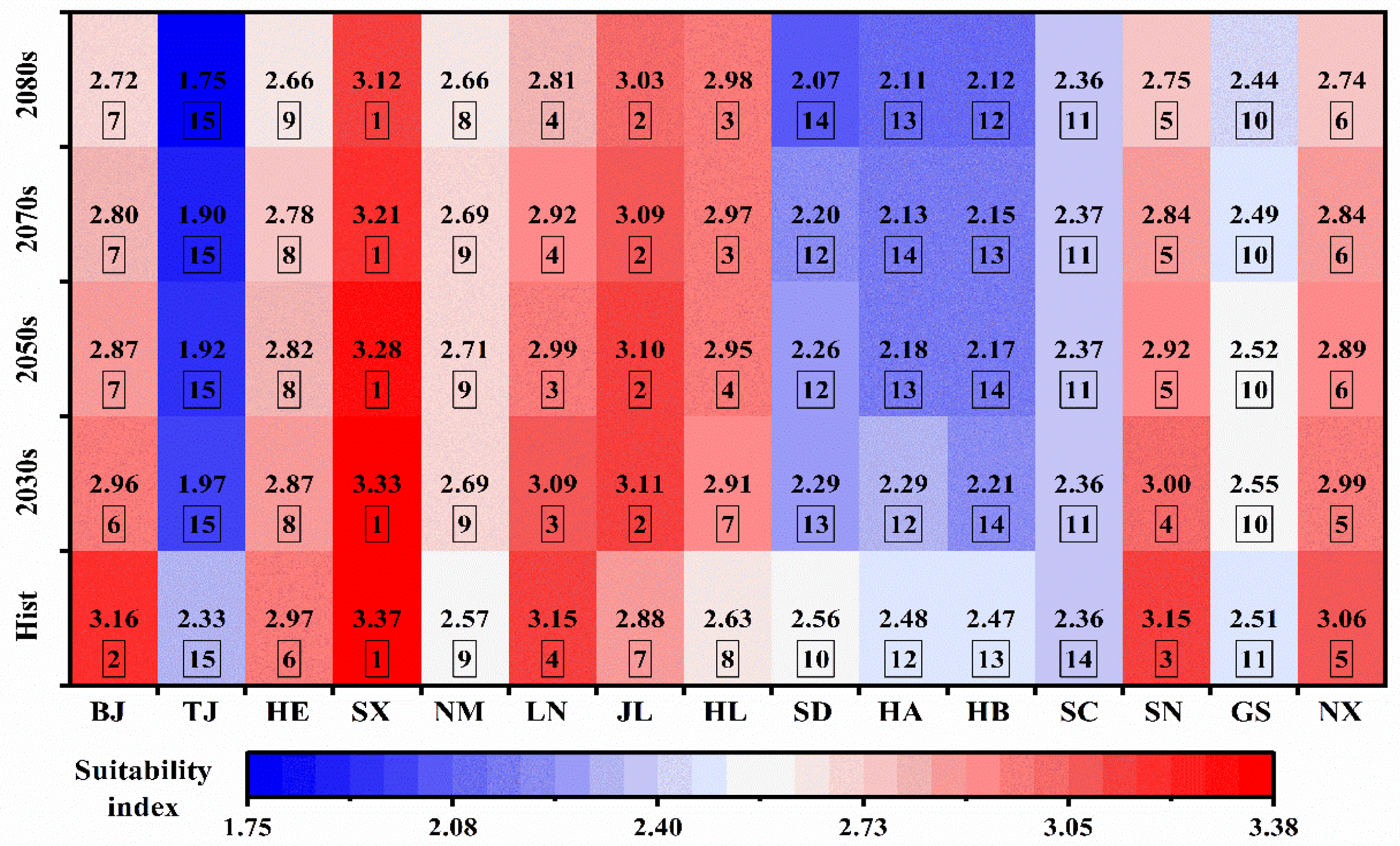
| Criteria | Extremely Suitable, 4 | Moderately Suitable, 3 | Marginally Suitable, 2 | Unsuitable, 1 |
|---|---|---|---|---|
| Mean annual temperature/°C | 2.95–10.18 | −0.70–2.95 or 10.18–12.80 | −4.40–−0.70 or 12.80–16.42 | <−4.40 or >16.42 |
| Mean annual precipitation/mm | 400–600 | 300–400 or 600–1400 | 200–300 or 1400–2100 | <200 or ≥2100 |
| DEM/m | 900–1300 | 200–900 or 1300–2000 | 20–200 or 2000–3500 | <20 or ≥3500 |
| Aspect/° | 157.50–202.50 | 112.50–157.50 or 202.50–247.50 | 67.50–112.50 or 247.50–292.50 | 0–67.50 or 292.50–360 |
| Criteria | Interaction Type |
|---|---|
| q(X1∩X2) < min(q(X1), q(X2)) | non-linear reduction |
| min(q(X1), q(X2)) < q(X1∩X2) < max(q(X1), q(X2)) | unifactorial non-linearity reduction |
| q(X1∩X2) = q(X1) + q(X2) | independent |
| q(X1∩X2) > max(q(X1), q(X2)) | bifactorial enhancement |
| q(X1∩X2) > q(X1) + q(X2) | non-linear enhancement |
| Suitable Levels (Suitability Index) | Unsuitable (1–2.1) | Marginally (2.1–2.6) | Moderately (2.6–3.1) | Extremely (3.1–4) |
|---|---|---|---|---|
| Number | 14 | 31 | 71 | 205 |
| Proportion | 4.36 | 9.66 | 22.12 | 63.86 |
| Climate Scenario | Time Period | Extremely Suitable | Moderately Suitable | Marginally Suitable | Unsuitable |
|---|---|---|---|---|---|
| 1981–2010 | 1.00 (10.89%) | 1.30 (14.09%) | 2.24 (24.26%) | 4.68 (50.76%) | |
| SSP1-2.6 | 2021–2040 | 1.30 (14.08%) | 1.08 (11.67%) | 1.64 (17.73%) | 5.22 (56.53%) |
| 2041–2060 | 1.31 (14.16%) | 1.05 (11.43%) | 1.55 (16.78%) | 5.32 (57.64%) | |
| 2061–2080 | 1.31 (14.24%) | 1.04 (11.28%) | 1.55 (16.81%) | 5.32 (57.68%) | |
| 2081–2100 | 1.31 (14.20%) | 1.05 (11.34%) | 1.56 (16.93%) | 5.31 (57.54%) | |
| SSP3-7.0 | 2021–2040 | 1.31 (14.20%) | 1.09 (11.77%) | 1.66 (17.95%) | 5.18 (56.08%) |
| 2041–2060 | 1.35 (14.63%) | 1.02 (11.05%) | 1.54 (16.69%) | 5.32 (57.63%) | |
| 2061–2080 | 1.31 (14.19%) | 1.00 (10.88%) | 1.56 (16.85%) | 5.36 (58.08%) | |
| 2081–2100 | 1.19 (12.86%) | 1.04 (11.25%) | 1.56 (16.95%) | 5.44 (58.94%) | |
| SSP5-5.8 | 2021–2040 | 1.31 (14.19%) | 1.07 (11.61%) | 1.60 (17.32%) | 5.25 (56.87%) |
| 2041–2060 | 1.32 (14.33%) | 1.01 (10.90%) | 1.51 (16.36%) | 5.39 (58.41%) | |
| 2061–2080 | 1.20 (13.02%) | 1.03 (11.19%) | 1.54 (16.70%) | 5.45 (59.09%) | |
| 2081–2100 | 1.03 (11.17%) | 1.10 (11.96%) | 1.58 (17.16%) | 5.51 (59.70%) |
| Climate Scenario | Time Period | Expansion | No Change | Contraction |
|---|---|---|---|---|
| 2021–2040 | SSP1-2.6 | 0.37 | 7.94 | 0.90 |
| SSP3-7.0 | 0.37 | 7.98 | 0.86 | |
| SSP5-5.8 | 0.39 | 7.87 | 0.95 | |
| Average | 0.38 | 7.93 | 0.90 | |
| 2041–2060 | SSP1-2.6 | 0.45 | 7.68 | 1.08 |
| SSP3-7.0 | 0.52 | 7.54 | 1.15 | |
| SSP5-5.8 | 0.58 | 7.35 | 1.28 | |
| Average | 0.52 | 7.52 | 1.17 | |
| 2061–2080 | SSP1-2.6 | 0.49 | 7.59 | 1.13 |
| SSP3-7.0 | 0.70 | 7.13 | 1.38 | |
| SSP5-5.8 | 0.82 | 6.80 | 1.59 | |
| Average | 0.67 | 7.17 | 1.37 | |
| 2081–2100 | SSP1-2.6 | 0.49 | 7.61 | 1.11 |
| SSP3-7.0 | 0.88 | 6.70 | 1.63 | |
| SSP5-5.8 | 0.96 | 6.46 | 1.79 | |
| Average | 0.78 | 6.92 | 1.51 |
Disclaimer/Publisher’s Note: The statements, opinions and data contained in all publications are solely those of the individual author(s) and contributor(s) and not of MDPI and/or the editor(s). MDPI and/or the editor(s) disclaim responsibility for any injury to people or property resulting from any ideas, methods, instructions or products referred to in the content. |
© 2024 by the authors. Licensee MDPI, Basel, Switzerland. This article is an open access article distributed under the terms and conditions of the Creative Commons Attribution (CC BY) license (https://creativecommons.org/licenses/by/4.0/).
Share and Cite
Yin, Y.; Wang, J.; Zhang, W.; Yin, B.; Huang, J.; Zhang, Z. Alterations in Suitable Cultivation Area for Scutellaria baicalensis under Future Climatic Scenarios in China: Geodetector-Based Prediction. Agronomy 2024, 14, 2065. https://doi.org/10.3390/agronomy14092065
Yin Y, Wang J, Zhang W, Yin B, Huang J, Zhang Z. Alterations in Suitable Cultivation Area for Scutellaria baicalensis under Future Climatic Scenarios in China: Geodetector-Based Prediction. Agronomy. 2024; 14(9):2065. https://doi.org/10.3390/agronomy14092065
Chicago/Turabian StyleYin, Yuanyuan, Jing’ai Wang, Wensheng Zhang, Benfeng Yin, Jixia Huang, and Zijing Zhang. 2024. "Alterations in Suitable Cultivation Area for Scutellaria baicalensis under Future Climatic Scenarios in China: Geodetector-Based Prediction" Agronomy 14, no. 9: 2065. https://doi.org/10.3390/agronomy14092065
APA StyleYin, Y., Wang, J., Zhang, W., Yin, B., Huang, J., & Zhang, Z. (2024). Alterations in Suitable Cultivation Area for Scutellaria baicalensis under Future Climatic Scenarios in China: Geodetector-Based Prediction. Agronomy, 14(9), 2065. https://doi.org/10.3390/agronomy14092065




